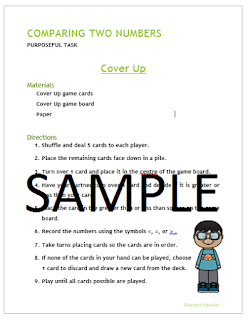Number sense refers to a student’s “fluidity and flexibility with numbers,” (Gersten & Chard, 2001). The student has a sense of what numbers mean, understands their relationship to one another, is able to perform mental math, understands symbolic representations, and can use those numbers in real world situations.
The National Council of Teachers in 1989 identified the following five components that characterize number sense:
- Number meaning
- Number relationships
- Number magnitude
- Operations involving numbers and referents for number
- Referents for numbers and quantities
Conceptual understanding of place value is integral to the development of numbers sense. Followers have asked about how I teach place value, as it is often the unit which kicks off a new school year. Due to requests, I have updated my Place Value resource on my TPT store. Click on the picture to obtain your free sample of my unit.
We begin by playing with big numbers and developing a sense of magnitude - students love reading and writing numbers beyond 1 000. We read their phone number as a large number and look for examples of the magnitude of numbers in our environment. Reading Schwartz' How Much is A Million culminates the investigation.
The students represent numbers in a variety of compositions - standard form, expanded form, written form, and with models. Activities for representing numbers are included in my freebie.
We continue with looking at number patterns on the hundreds chart, calendars, and on number lines. Activities for the hundreds chart and calendars are included in the free resource. This leads to an investigation of skip counting patterns. Students love to make a series of patterns - one which contains an error - and have a classmate deduce the incorrect sequence. We progress to order numbers in ascending and descending order.
We represent the relationship between numbers symbolically using <, >, and =. Again, activities to develop these conceptual understandings are found in my freebie.
The unit finishes with a look at estimating using referents. We place numbers on a number line and round numbers to the nearest 10 and 100. Once again, activities can be found in the free resource. The image below is the game board for the rounding activity.
I hope you had a restful summer and these ideas help make the transition back to school easier!
The students represent numbers in a variety of compositions - standard form, expanded form, written form, and with models. Activities for representing numbers are included in my freebie.
We continue with looking at number patterns on the hundreds chart, calendars, and on number lines. Activities for the hundreds chart and calendars are included in the free resource. This leads to an investigation of skip counting patterns. Students love to make a series of patterns - one which contains an error - and have a classmate deduce the incorrect sequence. We progress to order numbers in ascending and descending order.
We represent the relationship between numbers symbolically using <, >, and =. Again, activities to develop these conceptual understandings are found in my freebie.
The unit finishes with a look at estimating using referents. We place numbers on a number line and round numbers to the nearest 10 and 100. Once again, activities can be found in the free resource. The image below is the game board for the rounding activity.
I hope you had a restful summer and these ideas help make the transition back to school easier!










No comments:
Post a Comment